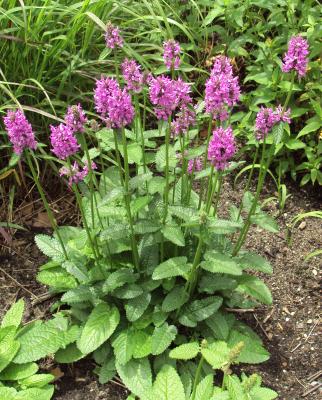Contents:
Common Names | Parts Usually Used | Plant(s) & Culture | Where Found | Medicinal Properties
Legends, Myths and Stories | Uses | Formulas or Dosages | Bibliography
Scientific Names

- Stachys officinalis L.
- Lamination
- Mint family
Common Names
- Lousewort
- Purple betony
- Wood betony
Parts Usually Used
Flowering herb
Back to Top
Description of Plant(s) and Culture
Betony is a perennial plant; the hairy, unbranched or slightly branched, quadrangular stem grows to a height of
Back to Top
Where Found
Found in old European gardens, damp or dry meadows, on sunny slopes, and along forest paths.
Back to Top
Medicinal Properties
Anthelmintic, astringent, carminative, diuretic, expectorant, vulnerary.
Back to Top
Legends, Myths and Stories
During the Middle Ages betony was grown in monastery gardens and was believed to ward off a host of evils, including mad dogs.
Back to Top
Uses
Betony is recommended for asthma and bronchitis, as well as for heartburn. The infusion is also popularly used for neurasthenia, neuritis, neuralgia, bladder and kidney problems, spitting blood, and excessive sweating; regular use is recommended for varicose veins. A strong decoction is said to be effective against worms. The juice of the plant can be used to heal cuts, external ulcers, and cold sores.
If you have a sprain, don’t throw away the leaves boiled to make a decoction; make them into a poultice to put on the injured part. Taking
Fresh betony leaf was believed to prevent drunkenness if chewed before a party, and, as a nightcap, an infusion is supposed to keep away bad dreams.
Betony tea is a good substitute for oriental black tea because it is similar in flavor. Can be used daily.
Back to Top
Formulas or Dosages
Infusion: use
Decoction: use
Back to Top
Bibliography
![]() Back to Eden
Back to Eden, by Jethro Kloss; Back to Eden Publishing Co., Loma Linda, CA 92354, Original copyright 1939, revised edition 1994
![]() The Herb Book
The Herb Book, by John Lust, Bantam Books, 666 Fifth Avenue, New York, NY. copyright 1974.
Herbal Gardening, compiled by The Robison York State Herb Garden, Cornell Plantations, Matthaei Botanical Gardens of the University of Michigan, University of California Botanical Garden, Berkeley., Pantheon Books, Knopf Publishing Group, New York, 1994, first edition
 The Magic of Herbs
The Magic of Herbs, by David Conway, published by Jonathan Cape, Thirty Bedford Square, London, England. (Out of print)
![]() American Folk Medicine
American Folk Medicine, by Clarence Meyer, Meyerbooks, publisher, PO Box 427, Glenwood, Illinois 60425, 1973
![]() The Yoga of Herbs: An Ayurvedic Guide to Herbal Medicine
The Yoga of Herbs: An Ayurvedic Guide to Herbal Medicine, by Dr. David Frawley & Dr. Vasant Lad, Lotus Press, Twin Lakes, Wisconsin, Second edition, 1988.
![]() Webster’s New World Dictionary
Webster’s New World Dictionary, Third College Edition, Victoria Neufeldt, Editor in Chief, New World Dictionaries: A Division of Simon & Schuster, Inc., 15 Columbus Circle, New York, NY 10023
![]() Country Home Book of Herbs
Country Home Book of Herbs, Meredith Books, Editorial Dept. RW240, 1716 Locust Street, Des Moines, IA 50309-3023, copyright 1994
